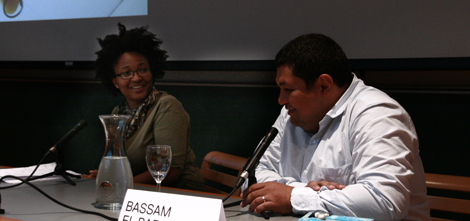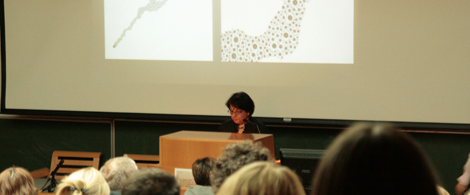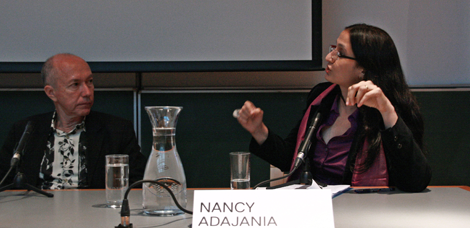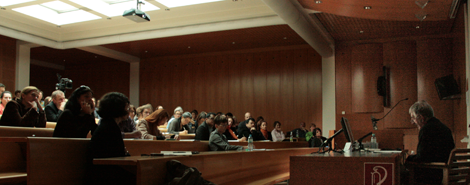Category: "Global Art"
So What Is It Now? - Global Art Symposium II
The second day of the global art symposium, consisting of two discussion rounds and several lectures, saw a rather theoretically-based first part with speakers like art curator and critic Maria Lind and Nancy Adajania, also curator, critic and a cultural theorist.
They demanded the museum to be built up as an international hub, not a space that exhibits but one that houses cooperation and processes. Another aspect brought up by Nancy Adajania was that of ethical responsibilities and what global art was against, which in her opinion is something that completely shifted towards the artist, giving him/her room to make their own ethical stands. She also sharply declined global art the protection of transculturality, which in her words "is no temple for it".
Things got interesting when global art was all of a sudden declared a condition that needed to be medicated and channeled, but how was not all that certain, aside from introducing new networks especially interlinking and aiding smaller projects and institutions everywhere.
The audience went into the lunch break with visibly full heads. Things got a bit more practical as artists Jitish Kallat and Senam Okudzeto took the stage in the afternoon, with a more theoretical interjection by Bassam El Baroni, curator and art critic who sharply seperated fine art from contemporary art and analysed the dynamic of the art market, explaining the different ways of making it as an artist today. He also proclaimed the end of art, claiming the artist working in an artificial timezone that is cut off from the past and the future, a statement that helps to make sense of a lot of art produced today.
Senam Okudzeto on the other hand was a lot more concrete in her exploration of globality, explaining the Ghana-based NGO Art in Social Structures (AISS, http://www.artinsocialstructures.org/), she has founded and she is executive director of. The organisation, it's members people from all across the globe, strives to free art in Ghana from its elitism and get the people in the street interested in it. The ensuing discussion made some interesting points, stating that artworks are actually not global, but stem from a location, travel the world and create local reactions. So how can this art that has become global through its travels be brought back to its local communities, and why is there even global art? As Senam Okudzeto sharply remarked, over these two days we slipped into easily talking about global art without questioning the term in itself, reminding us of the mail art of the 60ies and 70ies and adding that spam thus might be the new global art.
In the end, we come away with some answers and a lot more questions that have even more possible answers. To say it in the words Hans Belting, our very first speaker, started off his talk with, "it is difficult." Difficult, but oh so interesting. Maybe we should just all meet again next year and see if in the meantime we found some more answers and questions concerning this fascinating topic that is always in process. mp

The Path to Global Art - Symposium Day I
The first part of our global art forum saw Hans Belting, art historian and professor emeritus at the State University of Arts and Design, Karlsruhe, sketch out the way from world art, a term still rooted in colonialism and mostly meaning traditional art which made it unaccessible to contemporary non-western artists, to global art.
Monica Juneja from the University of Heidelberg then picked up the thread, turning into a slightly different direction though by questioning wether there can be a global art history, taking into consideration the disclipine eveolved with western art and is thus a concept embedded into it. In her opinion, it is mostly relationships that need to be thought over, between people and institutions, but also things like the fabled incongruity of the global and the local or the notion that the aesthetic and the politic are incompatible.

The following discussion, starring the aforementioned speakers plus Peter Friedl who is currently teaching the class titled "Images as Concepts" at the Alte Saline Hallein, very much circled around the very nature of global art. The experiment of trying to tie it to contemporary art led to what can almost be called a diss of the latter, with Hans Belting stating that artists today in fact should step out of the contemporary and Peter Friedl even going as far as saying that contemporary art makes him nervous and he tries hard not get lumped into it. Also discussed was the master narrative and how it had to be changed to confirm with the new global thinking. In the end, it was agreed global art was indeed a challenge that called for a lot of rethinking, that needed institutions to be less inert, perimeters to change, not only in the field of art history, but generally in all artistic areas and practises.
On this first day it was already interesting to see how many different positions and focusses are coming together here, be it those of practitioners or theorists, of speakers from formerly colonised areas or ones haling from those that did the colonising. For me, one of the most important questions remains to be asked: Is there actually a thing like global art?
The symposium continues on Saturday. mp

crisisss. Art and Confrontation in Latin America. 1910-2010
Still on view until June 5, 2011 at Palacio de Bellas Artes and Ex Teresa Arte Actual, Mexico City
www.bellasartes.gob.mx
Curated by Gerardo Mosquera, who is attending our symposium "Global Art" (29, 30 July 2011).
This exhibition presents an overview of confrontational and transgressive Latin American artworks dating from the hundred years following the Mexican Revolution. Featuring 103 artists and some 200 artworks, crisisss… is the largest and most wide-ranging show of its kind ever organized.
The Global Art System
on 29th and 30th of April, 2011 at Alexandria Contemporary Arts Forum (ACAF).
Samir Amin's analysis of the concept of Eurocentrism traces its origins back to the end of the 1970s, even if it seems to perfectly depict the world of the early 21st century: "Eurocentrism is anti-universalist, since it is not interested in seeking possible general laws of human evolution. But it does present itself as Universalist, for it claims that imitation of the Western model by all peoples is the only solution to the challenges of our time." Art history and the global art system are no exception to this ideological construction of a monolithic center of the world opposed to (or imitated by) a wide and undefined periphery. The workshop will focus on the Contemporary Art System, the legacy of Eurocentrism and the notion of internationalism in recent decades.
Lucrezia Cippitelli, PhD, is professor of Aesthetics at the Art Academy of L'Aquila, a visiting scholar at Cornell University, and invited curator of the TIME_FRAME project at NIMK, Amsterdam and is currently working as consultant curator for Habana Biennale. She is the author of Alamar Express Lab (Rome, Gangemi, 2007) and co-editor of Tania Bruguera (Milan, Postmedia, 2010).
ACAF's Artistic Director and Co-Founder Bassam El Baroni will speak at our Sympoisum "Global Art" (29, 30 July 2011)
more info
http://www.acafspace.org/
http://turbulence.org/blog/2011/04/12/lucrezia-cippitelli-the-global-art-system-alexandria/
Bassam El Baroni and Monica Juneja
:: Next >>



